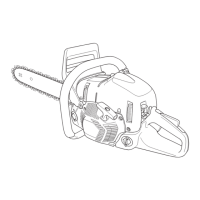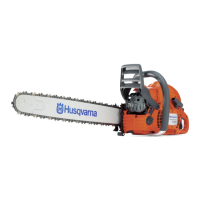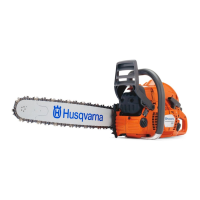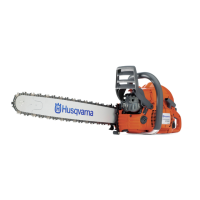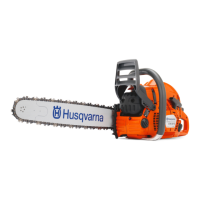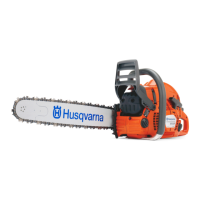Do you have a question about the Husqvarna 576XP AutoTune and is the answer not in the manual?
Explains symbols displayed on the chainsaw itself for safe operation and identification of parts.
Details symbols used within the operator's manual to convey important safety and operational information.
A welcoming message to the customer from Husqvarna, introducing the product and company heritage.
Identifies and labels all the main parts and components of the Husqvarna chain saw with numbered diagrams.
Essential checks and procedures to perform before operating the chainsaw for the first time.
Highlights critical safety advice, general principles, and common sense for safe chainsaw operation.
Specifies the mandatory personal protective gear required for safe chainsaw operation.
Details the built-in safety mechanisms of the chainsaw and their importance.
Explains the function and importance of the chain brake and front hand guard for user safety.
Critical warnings regarding machine modification, misuse, kickback, and environmental hazards like exhaust fumes.
Emphasizes safe operation, avoiding fatigue, alcohol, and ensuring proper ventilation.
Reinforces PPE use and the importance of proper maintenance and qualified service.
Emphasizes exercising caution, seeking expert advice, and continuous learning for safe operation.
Lists recommended PPE, including trousers, boots, helmet, hearing, and eye protection.
Explains the function of safety features like the chain brake and front hand guard.
Discusses scenarios where the chain brake might not activate or protect the user from kickback.
Explains the throttle lockout mechanism designed to prevent accidental throttle operation.
Details the function of the chain catcher and right hand guard for user safety.
Describes the system designed to reduce vibration transfer to the operator for comfort and safety.
Provides warnings and instructions regarding the muffler, including fire hazards and maintenance.
Outlines how to choose and maintain cutting equipment for optimal performance and safety.
Explains how specialized cutting equipment can reduce kickback risk and the importance of proper maintenance.
Details key bar specifications like length, groove width, and tip radius, and their impact on safety.
Describes chain specifications such as pitch, drive link width, and number of drive links for proper matching.
Provides instructions on sharpening cutting teeth and adjusting depth gauge settings for optimal cutting and safety.
Explains how to adjust the depth gauge setting for optimal cutting performance and kickback reduction.
Provides instructions on how to properly tension the saw chain to prevent it from jumping off.
Emphasizes the importance of proper chain lubrication for preventing chain snap and ensuring safety.
Details the type of chain oil to use and how to check if the lubrication system is working correctly.
Discusses checking drive sprocket wear and lubricating the needle bearing for longevity.
Details how to check the guide bar and saw chain for wear, cracks, and stiffness.
Step-by-step instructions for correctly fitting the guide bar and saw chain to the chainsaw.
Explains the correct fuel-to-oil ratio and recommends specific fuel and oil types for the chainsaw.
Provides guidance on gasoline types and the recommended two-stroke oil for the engine.
Advises on the use of special chain oil and its importance for lubrication and machine longevity.
Outlines safe procedures for refueling the chainsaw, including precautions against fire.
Provides essential safety measures related to handling fuel and mixing gasoline with oil.
Offers guidance on safely transporting and storing the chainsaw, including long-term preparation.
Step-by-step guide for starting a cold or warm engine, including choke and decompression valve use.
Reinforces safety precautions during starting and describes the correct technique for pulling the starter cord.
Explains the simple procedure for stopping the chainsaw engine using the stop switch.
A checklist of essential inspections to perform on the chainsaw before starting any work.
Basic safety rules and techniques for operating the chainsaw effectively and safely.
Explains the phenomenon of kickback and how to avoid it, emphasizing operator awareness.
Guidance on maintaining a safe stance and awareness of surroundings while operating the chainsaw.
Tips for maintaining a firm grip, avoiding kickback, and keeping control of the chainsaw during operation.
Discusses general cutting principles, including full throttle usage and avoiding cutting above shoulder height.
Explains fundamental cutting techniques, including using pulling and pushing chains and avoiding kickback.
Defines terms like cutting, limbing, splitting, and lists factors affecting safe cutting operations.
Provides instructions on what to do if the cutting chain becomes jammed during operation.
Specific advice for safely cutting branches off felled trees.
Demonstrates safe methods for cutting logs, considering support and potential for splitting or jamming.
Outlines the principles and experience required for safely felling trees.
Explains how to establish a safe distance and determine the correct felling direction for trees.
Instructions for clearing the work area and planning a safe retreat path before felling a tree.
Details the sequence and precision required for making directional and felling cuts to control tree fall.
Provides critical safety warnings and methods for dealing with a tree that has fallen incorrectly.
Safe techniques for cutting branches or trees under tension to prevent springback and injury.
Comprehensive guide on understanding and preventing kickback incidents.
Specific safety advice for limbing, focusing on avoiding the kickback zone and tensioned limbs.
Outlines the scope of user-performed maintenance and when professional service is required.
Explains the AutoTune system and its role in automatic carburetor adjustment for optimal performance.
Details essential checks for chain saw safety equipment, including chain brake and hand guard.
Specific procedures for inspecting the chain brake band and the front hand guard for damage and wear.
Instructions for verifying the correct operation of the inertia brake release and brake trigger mechanisms.
Explains how to check the throttle lockout mechanism for proper return and function.
Guidance on inspecting the chain catcher and right hand guard for damage and secure attachment.
Details how to regularly check the vibration damping units for cracks or deformation.
Instructions for checking the muffler's attachment and cleaning the spark arrestor screen.
Provides instructions for replacing a worn starter cord or recoil spring, including safety precautions.
Step-by-step guide for tensioning the recoil spring when replacing the starter cord.
Instructions for fitting the starter and cleaning/replacing the air filter to prevent engine issues.
Guidance on checking, cleaning, and replacing the spark plug and lubricating the bar tip sprocket.
Instructions for lubricating the needle bearing and adjusting the oil pump for proper chain lubrication.
Explains the importance of cleaning the cooling system and the centrifugal air injection system.
Special measures and kit fitting for operating the chainsaw in cold and snowy conditions.
Information on heated handles available on specific models for improved comfort in cold weather.
A detailed schedule outlining daily, weekly, and monthly maintenance tasks for the chainsaw.
Provides detailed technical data for the engine, including displacement, bore, stroke, and power.
Lists specifications for the ignition system, carburetor type, and fuel/oil capacities.
Specifies chainsaw weight and key bar/chain dimensions like pitch and drive link thickness.
Lists recommended original and replacement bar and chain combinations for optimal safety and performance.
Provides information and specifications for filing saw chains and using file gauges.
Covers warranty rights, owner responsibilities, and maintenance requirements for emission control systems.
Details warranty period, what is covered, what is not covered, and how to file a claim.
Lists emission-related parts covered by warranty and the maintenance statement.
Presents safety precautions for chain saw users, referencing ANSI B175.1-2000 standards.
Specific advice on preventing kickback, including proper grip, avoiding the nose, and cutting techniques.
Additional safety measures covering one-handed operation, fatigue, fuel handling, and general operation.
| Engine Power | 4.2 kW |
|---|---|
| Cylinder Displacement | 73.5 cm³ |
| Weight (without cutting equipment) | 6.6 kg |
| Fuel Tank Volume | 0.7 liters |
| Chain Pitch | 3/8" |
| Chain Gauge | 0.058" |
| Chain Brake | Yes |
| Air Filtration | Centrifugal air cleaning system |
| Bar Length Range | 38-71 cm |
